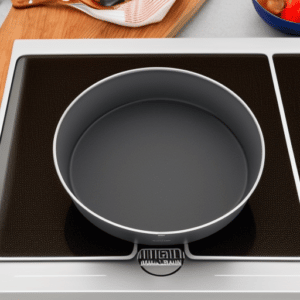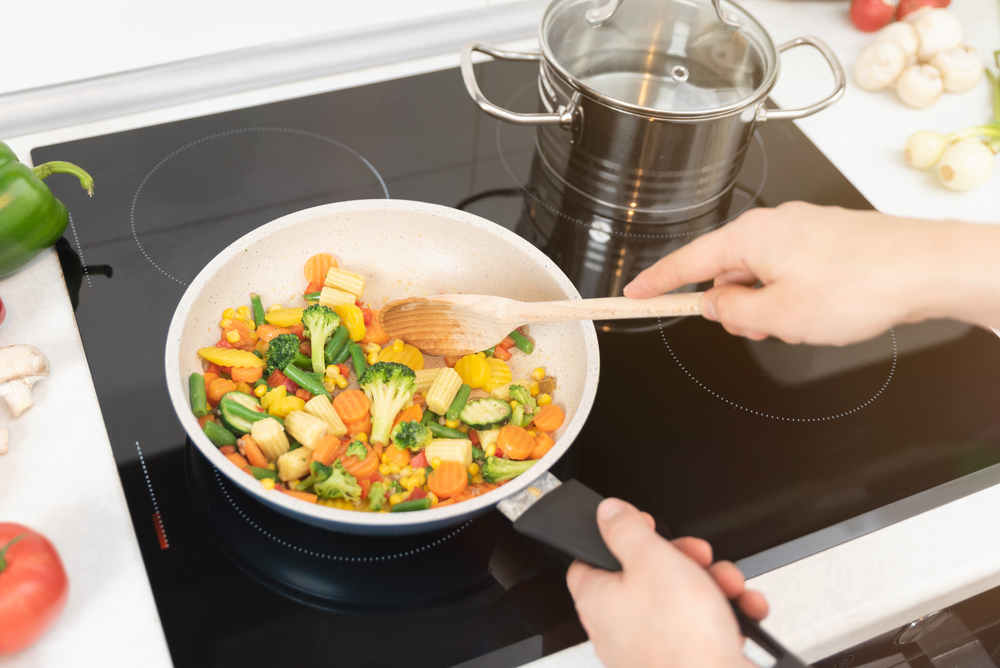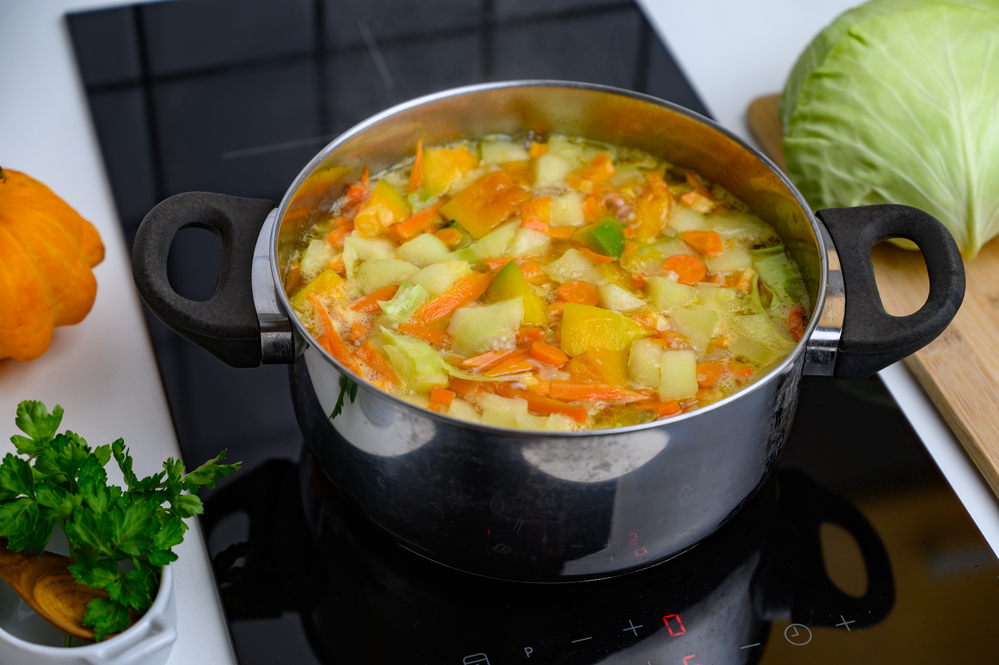Have you ever wondered, though, why using any of this cookware can help your food cook quickly and evenly?
Induction hobs use electricity to produce a magnetic field that creates heat in an induction pan. While this may not seem straightforward yet, don’t worry, this article answers the question “how do induction pans work?” in greater detail. To understand which pans work, which does not, and why, we will also cover some other typical concerns.
How Induction Pans and Hobs Work Explained
How Do Induction Cooktops Work?
Induction cooking works by heating a pot or pan via electrical induction, also known as electromagnetic induction. In simple terms, this means generating electricity using a magnetic field. Gas stoves and electric cooking use a heating element, or thermal conduction, to produce heat, whereas induction cooking heats the pan using magnetic fields on the cooking surface.
Induction cookers feature a smooth glass-ceramic surface with a coil of copper wire located beneath. When operating, an electrical current passes through the coil at a high frequency to the pan, resulting in an erratic magnetic field that produces eddy currents.
The rotating eddy currents flowing through resistance in a cooking vessel cause the pan to heat up. Hence, the energy transfer created by induction stoves’ electrical and eddy currents is highly efficient. Interestingly, it helps you save energy, especially when compared to a gas or electric hob.
How Do Induction Pans Interact With an Induction Cooktop?
What’s impressive is that the heat energy comes from the cooking pot or cooking pan, not the induction stove cooktop. Hence, quicker cooking times for your food.
Moreover, induction hobs can boil water half the time as gas and electric hobs. However, keep in mind that only induction hob-compatible cookware will facilitate the current flow, creating heat.
This electromagnetic induction heating only works with a magnetic pot or pan that contains iron to interact with the magnetic field created. Stainless steel and cast iron pans are perfect for this as they are heavy and ferrous. Aluminium pans and copper pans will not work on an induction cooker unless they have additional materials built into the structure.
One of the best parts about induction cooking and induction pots and pans is that the entire pan gets hot thanks to the bouncing magnetic field interacting with the metal of the cookware. And there are no hot spots. As a result, the heat produced is evenly transferred to the food within the pots and pans.
How Do You Know if a Pan Is Induction Cooktop Compatible?

With all this talk about which pans are suitable for use on an induction hob, you may be wondering if some of your existing cookware is compatible or not. Unfortunately, many pots and pans have an outer coating or various materials, so determining if they are made from cast iron or stainless steel isn’t always as straightforward.
To determine if a pot or pan can be used on an induction hob, first check for an induction-compatible symbol on the base. The symbol looks like a spring. If you do not see this, you can check using a magnet. Hold a magnet up to the base of the pan, and if it sticks, it can be used on an induction hob.
If the magnet does not stick, it is unsuitable for an induction hob. If the magnet seems to stick somewhat but not very well, it is possible your pan is made with a mix of materials and shouldn’t be used on an induction hob. This is common with less expensive stainless steel cookware.
Can You Make Normal Pans Work on Induction Cooktops?
If you find some of your pots and pans not working on an induction hob, you may be wondering if there is some hack that will make them adaptable. If so, you wouldn’t be the only one because there is a way to convert your pots and pans to make them compatible with an induction hob.
If you do not want to buy new cookware, you can always purchase induction pads that adhere to the base. However, this method is not as efficient as using a completely compatible material.
What Are the Advantages of Cooking With Induction Hobs?
Considering the need for special cookware, is induction cooking worth the hassle? We think so, and so do many chefs. Cooking with an induction hob comes with various advantages, so it’s no wonder they are growing in popularity. Many homes and even businesses have shifted from the traditional stove to induction hobs.
Energy Efficient
First, induction hobs are more energy efficient. Since their cooking times range from 25% to 50% faster than electric and gas hobs, they use less power. Aside from the direct draw of mains power, greater energy efficiency is achieved by an induction pan transferring more heat to the food than other methods.
Environmentally Friendly
Less heat dissipation also results in less air pollution, particularly when compared to gas hobs which produce nitrogen oxides. However, even electric hobs can also generate unhealthy particulates in the air. With induction hobs, you get neither of these.
Cooking Times
Induction hobs are also more convenient, thanks to their faster cooking times. The magnetic energy produced by an induction hob creates heat in the pan almost instantly. So instead of waiting for the burner and pan to heat up, the pan starts cooking in just a few moments.
Safety
An induction hob cooktop does not get hot while you cook. Only the pan on top becomes hot, which increases the overall safety of using a hob. The pan will transfer some heat to the cooktop while in use, but the surface stays cool.
Easy to Clean
Unlike an electric or gas hob cooktop with burners or burner grills, an induction hob cooktop is much easier to clean. It has a smooth surface that can be cleaned with a quick wipe in most cases. There are no crevices or moving parts for food to build up and accumulate.
Extra Features
Some induction hobs also have various upgraded features, improving convenience and usability. These upgraded features include coil timers, an automatic shutoff for added safety, a temperature sensor, or even remote control over the settings via an app.
What Are the Disadvantages of Cooking With Induction Hobs?

After reading through the wide range of advantages, it is time to address the possible disadvantages of cooking on an induction hob. While there are not nearly as many disadvantages, they do still exist.
First, an induction hob typically costs a bit more than traditional hobs. While induction hobs have recently become more competitive, they still cost more than your typical hob.
Second, induction pans must contain iron for them to work. Your glass, copper, and aluminium pans will not work on an induction cooker. Fortunately, today’s cooking products are specifically made for use on an induction hob, so they won’t be hard to find if you don’t already have some. Of course, this also adds to the initial cost listed above, further compounding the first disadvantage.
Induction Cooking Made Easy
Now that we know all about the science behind induction cooking and how induction pots and pans work, what do you think? Do you think cooking meals with a magnetic field could be the right choice for you and your home?
Electromagnetic induction cooking brings several perks that anyone would ask for. With this cookware, you can heat and cook your food much faster than electric or gas hobs, which helps you save on electricity and ensures safety in your kitchen.
On the other hand, if you do not have an induction hob or the right pots and pans, it could require an initial investment cost. It is worth considering, especially if you want to upgrade your existing kitchen, practice sustainable cooking, and maximize your time preparing meals.
Are you convinced now why induction pans are worth investing in? We would like to know your thoughts. So let us know what you think by typing in your comments below.

